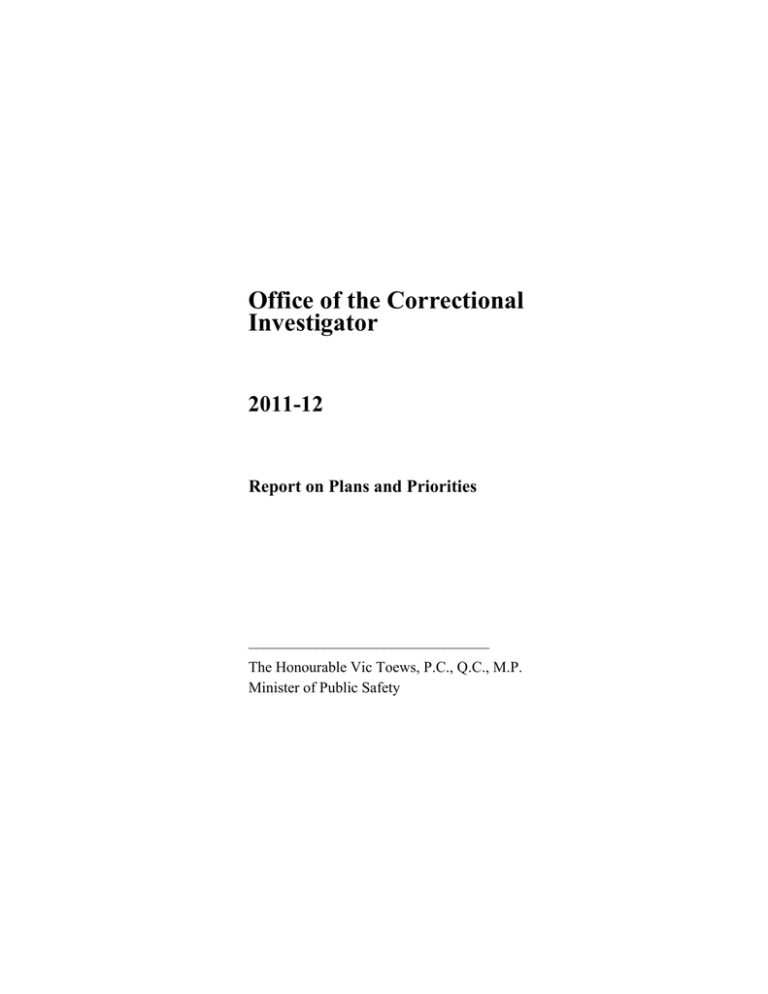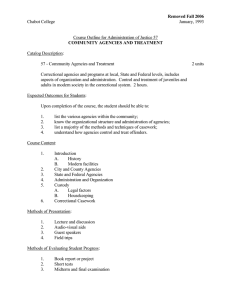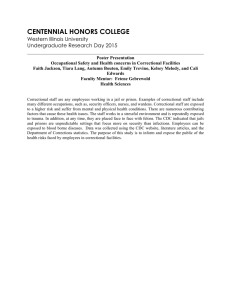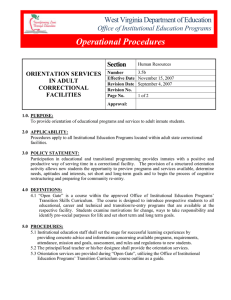Office of the Correctional Investigator 2011-12 Report on Plans and Priorities
advertisement

Office of the Correctional Investigator 2011-12 Report on Plans and Priorities –––––––––––––––––––––––––––––––– The Honourable Vic Toews, P.C., Q.C., M.P. Minister of Public Safety Table of Contents Correctional Investigator’s Message................................................................................... 4 Section I: Departmental Overview .............................................................................. 6 Raison d’être and Responsibilities...................................................................................... 7 Section II: Analysis of Program Activities by Strategic Outcome ......................... 14 Section III: Supplementary Information .................................................................. 18 Section IV: Other Items of Interest........................................................................... 20 Correctional Investigator’s Message The mandate of the Office of the Correctional Investigator (OCI) reflects fundamental elements of Canadian democratic values and traditions in our criminal justice system. The OCI is one of many oversight agencies that exist to provide independent assurance to Canadians and parliamentarians that federal services and programs are delivered in an open, transparent and accountable manner. As an ombudsman for federally sentenced offenders, independence, impartiality and respect for human rights are the foundations of my Office’s mandate. The work performed by investigative staff and their ongoing dedication to ensure legal and policy compliance and fair decision-making, is rooted in the principle that offenders, like every other Canadian, must be treated with dignity and accordance with the rule of law. During the timeframe of this Report, the work of this Office will touch on a wide range of issues – the delivery of physical and mental health services in corrections; specific concerns affecting Aboriginal offenders as well as federally sentenced women; access to programming; conditions of confinement; and the need to do more to prevent deaths in custody. In addition, the OCI will continue moving to achieve a greater balance in managing the systemic nature of issues reviewed by our Office while fulfilling its core mandate: providing redress for individual offender complaints. In operating in this manner, we believe we can better serve Canadians. A particular area of overarching concern to the OCI is the current climate found within correctional institutions that is increasingly harsh, tense and stressed. This reality is undermining rehabilitation efforts and has its roots in the serious capacity challenges facing the Correctional Service of Canada. In addition, correctional facilities are ill-equipped to manage the needs of offenders who fall outside the description of general inmate population. For lack of alternatives, groups of offenders are being placed for prolonged periods of time in segregation-like units that operate outside the protections and procedural safeguards normally associated with the most isolated form of custody. In the absence of any kind of special programming, these offenders cannot access the kind of care, treatment, resources and interventions they require. Finally, as discussed in several previous reports, one of the major challenges and risks facing the OCI has been the sustainability of resources to enable us Correctional Investigator’s Message 4 to successfully deliver our mandate. In recognition of these challenges, the OCI received permanent program integrity funding to address increasing workload pressures related to volume of offender and third party complaints; the complexity of cases; and the need for special reviews which has arisen in response to several emerging trends in the correctional environment. This funding continues to be used in the reporting period to enhance the OCI’s investigative and corporate capacity. The original version was signed by Howard Sapers Correctional Investigator 5 Office of the Correctional Investigator Section I: Departmental Overview Section I: Departmental Overview 6 Raison d’être and Responsibilities The Office of the Correctional Investigator (OCI) provides Canadians with timely, independent, thorough and objective monitoring of their federal correctional system to ensure that it remains safe, fair, humane and effective. Essentially, its oversight role is to ensure accountability of the Correctional Service of Canada (CSC) in carrying out its statutory mandate in compliance with its domestic and international legal and human rights obligations. The mandate of the OCI, as defined by the Corrections and Conditional Release Act, is to function as an Ombudsman for federal offenders. The organization is independent of the Correctional Service of Canada and may initiate an investigation on receipt of a complaint by or on behalf of an offender, at the request of the Minister or on its own initiative. The Correctional Investigator is required by legislation to report annually through the Minister of Public Safety to both Houses of Parliament. Strategic Outcomes and Program Activity Architecture (PAA) The OCI’s strategic outcome is: “The problems of offenders in the federal correctional system are identified and resolved in a timely fashion” and is consistent with the organization’s legislative mandate. The main program activity is “Ombudsman to federal offenders”, which encompasses three operational priorities and five investigative priorities. The OCI’s five investigative priorities consist of those areas of focus identified as part of the Office’s strategic planning exercise, namely, offender access to health services, conditions of confinement, deaths in custody, Aboriginal issues, and access to programs in federal custody, with federally sentenced women recognized as a horizontal concern within this framework. The OCI will undergo a review of its service delivery standards for all complaint types with a view to increase effectiveness. The other program activity, “Internal Services”, supports the delivery of the Office’s Ombudsman role to federal offenders as well as its corporate obligations to the Central Agencies of Government. 7 Office of the Correctional Investigator GOVERNMENT OF CANADA STRATEGIC OUTCOME Safe and Secure Communities OCI STRATEGIC OUTCOME The problems of offenders in the federal correctional system are identified and resolved in a timely fashion PROGRAM ACTIVITIES Ombudsman to federal offenders Internal Services Planning Summary Financial Resources (thousands) 2011–12 2012–13 2013–14 4,292 4,652 4,652 Human Resources (Full-time Equivalent – FTE) 2011–12 2012–13 2013–14 34 36 36 . Section I: Departmental Overview 8 Strategic Outcome : The problems of offenders in the federal correctional system are identified and resolved in a timely fashion Performance Indicators Targets Percentage of recommendations from the Annual Report and other significant reports issued by the OCI that are accepted in whole or in part by Correctional Service of Canada. 100% Following the prioritization of workload, percentage of offender complaints (closed cases) responded to in a timely fashion. 100% Program (1) Activity Ombudsman to federal offenders Internal Services 2011–12 2012–13 2013–14 $3,258 $3,434 $3,722 $3,722 $858 $858 $930 $930 $4,292 $4,652 $4,652 Total Planned Spending (1) Planned Spending (thousands) Forecast Spending 2010–11 Alignment to Government of Canada Outcomes Safe and Secure Communities n/a Estimates by Vote are presented in the 2011–12 Main Estimates which are available here: http://www.tbs-sct.gc.ca/est-pre/20112012/me-bpd/info/info-eng.asp 9 Office of the Correctional Investigator Contribution of Priorities to Strategic Outcomes Operational and Investigative Priorities Type Links to Strategic Outcome Description 1. Investigate and resolve individual offender issues. Ongoing All three operational priorities contribute toward the attainment if the organization’s strategic outcome: “The problems of offenders in the federal correctional system are identified and resolved in a timely fashion”. The primary role remains to investigate individual offender complaints through institutional visits, interviews with offenders, offender groups and CSC staff. Although resources (current and incremental) will be directed to lead and conduct systemic reviews and investigations, individual complaints will continue to be prioritized, responded to and resolved accordingly up until the matter is closed in DATIS – the case management tool. 2. Review the CSC’s management of mandated issues – s. 19 (serious bodily injury) investigations and use of force incidents. Ongoing This involvement is required as per the Corrections and Conditional Release Act. Review of the CSC’s section 19 investigations and reports; make representations and/or recommendations to CSC officials at the appropriate level; and monitor/evaluate their response. The review and assessment of use of force incidents is in keeping with the recommendations of the Arbour Commission of Inquiry. 3. Investigate, resolve Ongoing and provide leadership on specifically identified systemic issues stemming from the Section I: Departmental Overview Conduct reviews and investigations in these areas; Assume a national leadership role on key issues affecting these corporate priorities; 10 corporate priorities and of particular offender concern (e.g., Mental health issues; Aboriginal offender issues; preventable deaths in custody; program access; and, and conditions of confinement). Federally sentenced women will be treated as a horizontal priority. increased outreach efforts towards vulnerable groups including those suffering from mental health issues. Review and make recommendations on the Correctional Service of Canada’s policies and procedures. Use comparative analysis of CSC’s statistics; institutional performance relating to these corporate priorities; oversight and evaluation through follow-up and impact analysis of CSC’s response. The organization will focus its efforts and resources in these areas. Management Priorities Type Links to Strategic Outcome Description Information Management Ongoing This management priority is linked to the organization’s strategic outcome as the effective management of information is closely linked to the organization’s ability to respond to offender concerns and complaints and respond to legislative requirements under the Access to Information and Privacy Acts. In the last reporting period, the organization staffed an indeterminate Chief, Information Management position. The incumbent’s role and focus will be to ensure the OCI remains on course in its IM evolution, update the necessary systems and procedures to ensure that information is effectively and rigorously managed, provide ongoing training, and begin the movement to the electronic management of information. 11 Office of the Correctional Investigator Risk Analysis Maintaining an independent and objective review process within a correctional environment where the Office has virtually no control over either the number of complaints or the extent of the required investigations presents a number of unique challenges: ● the Office’s mandate is national in scope and offers, by the sheer number and complexity of issues, opportunities and shifting priorities. The client base and network of stakeholders are dispersed in a large number of often geographically remote locations throughout Canada; ● a series of enacted and proposed legislative measures will substantially increase the offender population and create additional pressures to the organization’s capacity to meet its legislative mandate; ● the resolution of complaints in an environment traditionally closed to public scrutiny, requires that the Office not only be, but be seen to be independent of both the Correctional Service of Canada, Public Safety Canada and the Minister; and ● given that the authority of the Office rests with its power of persuasion and quality of reporting rather than enforceable recommendations, it is imperative that appropriate administrative and public mechanisms be available to ensure that reasonable, fair and timely action is taken on the findings made by the Office. In addition, the Office does not foresee a decline in either the overall demand for services or in the complexity of the issues it is called upon to address. The environment in which it operates continues to be extremely challenging. As documented in the OCI’s 2009-10 Annual Report, the environment inside federal penitentiaries is increasingly tense, crowded, volatile and stressed. These conditions are challenging to the CSC’s ability to provide safe and effective custody. Moving forward requires not only innovative and dedicated services, but also sound risk management, knowledge-driven decisionmaking, rigorous stewardship, clear accountabilities and responsible spending. *The Office of the Correctional Investigator Annual Report can be found at: http://www.oci-bec.gc.ca Section I: Departmental Overview 12 Expenditure Profile OCI ten-year spending trend and forecast (Thousands) As reflected in this chart, from 2004-2005 to 2008-2009 spending was relatively consistent and averaged just over $3.0M annually. In 2009-2010, as a result of significant temporary funding received from the Management Reserve, the organization’s spending increased to $3.5M. As a result of new funding received from several legislative initiatives as well as permanent incremental funding from the Fiscal Framework, the last four years of the chart show the organization forecasting an increase in spending to $4.1M in 2010-2011; $4.2M in 2011-2012 and $4.6M in 2012-2013 and 2013-2014. Estimates by Vote Estimates by Vote are presented in the 2011–12 Main Estimates which are available here: http://www.tbs-sct.gc.ca/est-pre/20112012/me-bpd/info/info-eng.asp. 13 Office of the Correctional Investigator Section II: Analysis of Program Activities by Strategic Outcome Section II: Analysis of Program Activities by Strategic Outcome 14 Strategic Outcome The OCI has a single strategic outcome which is “the problems of offenders in the federal correctional system are identified and resolved in a timely fashion” is supported by its main program activity “Ombudsman to federal offenders”. The table below describes how the organization’s main program activity aligns to the Strategic Outcome, and how the organization plans to measure success and ultimately benefit Canadians. Program Activity by Strategic Outcome Program Activity : Ombudsman to federal offenders Human Resources (FTEs) and Planned Spending (thousands) 2011–12 2012–13 FTEs Planned Spending FTEs 30 3,434 32 2013–14 Planned Spending 3,722 FTEs 32 Planned Spending 3,722 Program Activity Expected Results Performance Indicators Targets To provide responsive and timely Ombudsman services to federal offenders Percentage of completed institutional visits 100% completion rate as per OCI policy and service delivery standards Percentage of responses to individual offender complaints (closed cases) by timeframe 100% completion rate as per OCI policy and service delivery standards Percentage of usage by inmate population of OCI services as indicated by the number of interviews and contacts as per DATIS entries 15 Increased percentage of usage in comparison to fiscal year 2009-10 Office of the Correctional Investigator Percentage of acceptance by CSC of OCI recommendations on key systemic areas of offender concern 100% of all recommendations made to the CSC are accepted in whole or in part Number of section 19 and Use of Force cases reviewed 100% completion rate as per OCI policy and service delivery standards Planning Highlights The assumptions found in this Report on Plans and Priorities stem from an ongoing strategic planning exercise in which a review of investigative procedures and practices is being completed with a view to confirming the organization’s alignment with its mandate. From this exercise, five corporate priorities - mental health issues, Aboriginal issues, preventable deaths in custody, program access and conditions of confinement were identified as investigative priorities and a focal point for the organization. In addition, the Office will continue its work as it relates to federally sentenced women. Going into the first year of this Plan, the organization will house a full complement of investigative staff that will contribute to the delivery of the mandate, bolster systemic investigations and continue to effectively respond to individual offender complaints. It is expected that turnover may begin to occur in year two of this Plan as this will coincide with the third and fourth year of employment for several individuals hired since 2009-2010. In preparation for this possibility, the organization will rely on the ongoing establishment of pools of qualified candidates at every level within the investigative stream. Section II: Analysis of Program Activities by Strategic Outcome 16 Benefits for Canadians The Office of the Correctional Investigator provides Canadians with timely, independent, thorough and objective investigations into problems of offenders to ensure a safe, secure, fair, equitable, humane, reasonable and effective correctional environment. By the very nature of the organization’s mandate, Canadians benefit when an offender’s human rights are upheld and correctional programs contribute towards his/her timely and effective reintegration into society. The Office and the work performed by staff contribute toward this positive outcome. Program Activity: Internal Services Human Resources (FTEs) and Planned Spending (thousands) 2011–12 2012–13 2013–14 FTEs Planned Spending FTEs Planned Spending FTEs Planned Spending 4 858 4 930 4 930 17 Office of the Correctional Investigator Section III: Supplementary Information Section III: Supplementary Information 18 Financial Highlights Future-oriented financial statements can be accessed at the Office of the Correctional Investigator Website: http://www.oci-bec.gc.ca Future-oriented Condensed Statement of Operations For the Year (Ended March 31) ($ thousands) Expenses Total Expenses Future-oriented 2011–12 Future-oriented 2010–11 $4,573 N/A $4,573 N/A - - - - $4,573 N/A Revenues Total Revenues Net Cost of Operations Supplementary Information Tables The following supplementary information tables included in the 2011–12 Report on Plans and Priorities can be found on the Treasury Board of Canada Secretariat’s web site at: http://www.tbs-sct.gc.ca/rpp/2010-2011/info/info-eng.asp. - 19 Greening Government Operations Office of the Correctional Investigator Section IV: Other Items of Interest Section IV: Other Items of Interest 20 The Office of the Correctional Investigator Website: http://www.oci-bec.gc.ca E-mail: org@oci-bec.gc.ca Enabling legislation: Corrections and Conditional Release Act S.C. 1992 Part 3 found at http://www.justice.gc.ca Reports and Discussion Papers found at the Office of the Correctional Investigator’s website (http://www.oci-bec.gc.ca): - Correctional Investigator’s Annual Reports - Previous Departmental Performance Reports and Reports on Plans and Priorities - Financial Statements (Historic and Future-oriented) - Under Warrant: A Review of the Implementation of the Correctional Service of Canada’s Mental Health Strategy - Quarterly Assessments of the Correctional Service of Canada’s Response to Deaths in Custody Reports and Investigations - Deaths in Custody – Final Report - 21 Office of the Correctional Investigator





